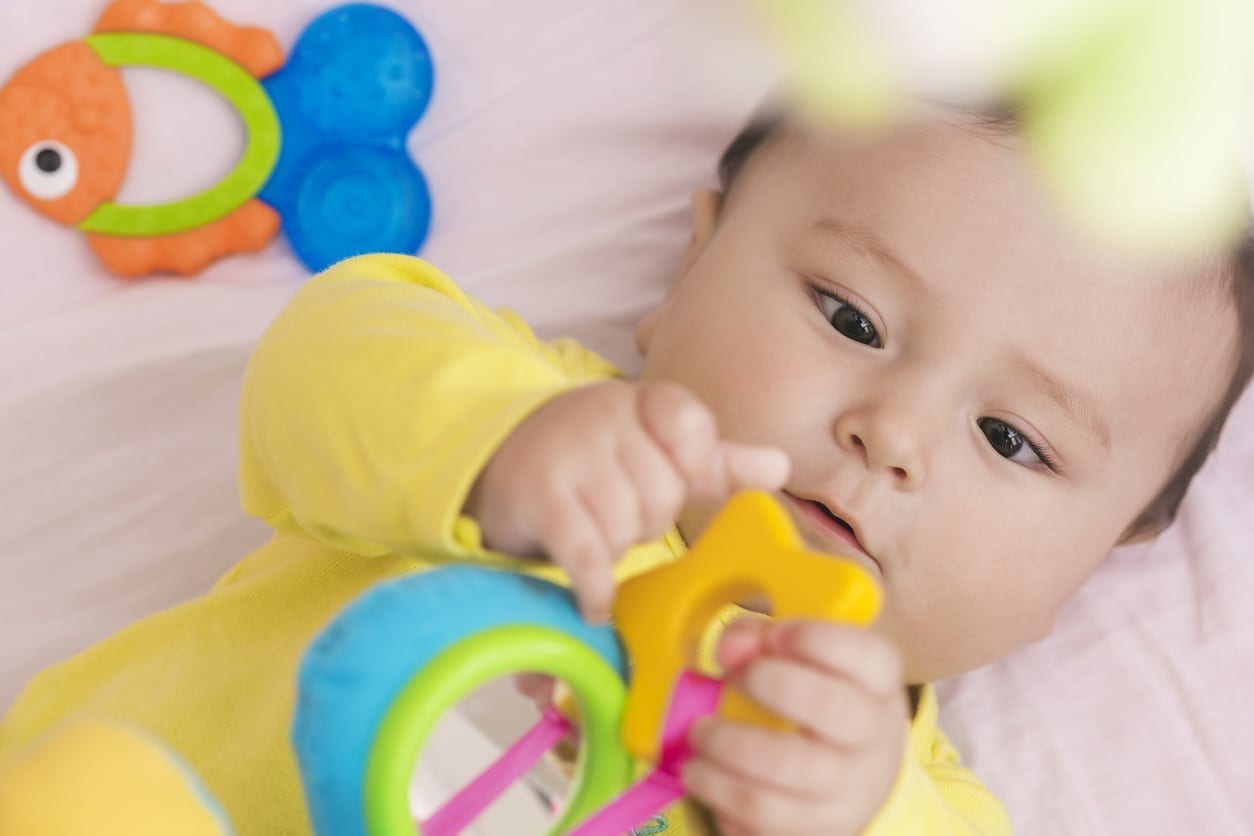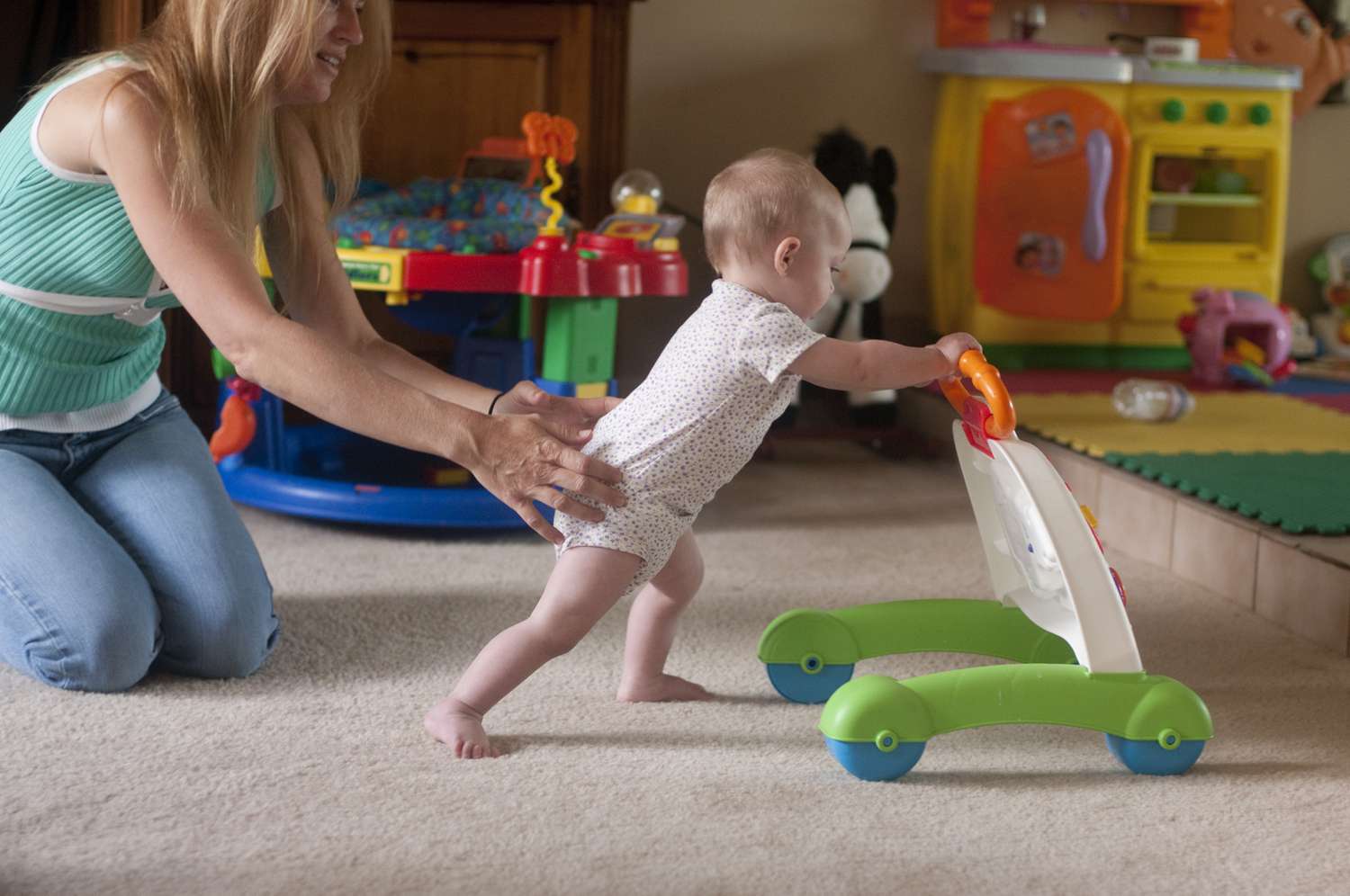
Between 3-6 months, your baby makes huge strides cognitively and physically as their senses come alive. Creating nurturing play environments facilitates key developmental milestones in spatial understanding, motor skills and sensory exploration. This guide will explain engaging activities, the best developmental toys and their benefits to enrich your baby’s emerging abilities.
Fostering Spatial Understanding (3 – 6 Mths)
Your 3-6 months old is increasingly aware of the world around them. Activities sparking visual tracking and spatial perception pave the way for future visual processing and problem solving.
Try dangling toys on activity gyms at varying heights, encouraging your baby to raise their head and reach across their body. Rotate mobiles around the crib, stroller or play mat to provoke side-to-side head turning and build peripheral vision.
Place bold pictures or patterned cards around the room within sight. Name and point to the images as your baby follows with their eyes. Slowly build a visual vocabulary.
Recommended Toys:
- Crib mobiles with rotating toys, music and lights
- Activity gyms with dangling toys on adjustable arcs
- Black and white cards with simple patterns
- Soft balls with bells inside for visual and auditory tracking
Benefits:
- Strengthens eye muscles and visual acuity
- Develops visual tracking skills
- Builds understanding of spatial relationships
- Fosters awareness of surroundings
- Promotes vestibular development
Mirrors are great for curious babies discovering themselves and differentiating from the environment. Select unbreakable baby mirrors and supervisedly let your baby observe movements like opening and closing hands. Celebrate these beginnings of self-awareness!
Building Fine Motor Dexterity (3 – 6 Mths)
Grasping, holding, transferring toys between hands – such play builds the fine motor skills crucial for future dexterity.
Provide lightweight rattles, textured toys and links for tiny hands to practice grasping Cross toys from one hand to the other to strengthen coordination. Place engaging objects just out of reach to encourage scooting closer. Assist in successful holding with your hands if needed.
Toys with pop up surprises activated by light touch provoke curiosity and refine finger control. SUPERVISE actively during play given the choke hazard.
Recommended Toys:
- Lightweight rattles of various shapes and materials
- Links with easy to grasp textures
- Activity center with pop-up elements
- Plush toys with tags for grasping and chewing
- Balls that chirp or light up when batted
Benefits:
- Develops hand strength and coordination
- Builds eye-hand connection
- Fosters reaching and grasping skills
- Encourages fine motor control
- Provides sensory stimulation through touch
Mastering Tummy Time (3 – 6 Mths)
Tummy time play starting 3-6 months builds strength to sit upright, roll over and crawl. Try placing a rounded neck pillow under the chest for support. Prop up activity gyms within reach for swatting and batting practice. Attach engaging toys to pram hoods for motivation.
Place mirrors around the play mat so your baby lifts and turns their head watching themselves. Read books and play music to keep them entertained. Start with a few minutes of supervised tummy time, increasing gradually based on cues.
Recommended Toys:
- Baby-safe mirrors around tummy time mat
- Activity gyms with dangling, high-contrast toys
- Crinkle books and rattle toys within reach
- Neck pillows providing support and comfort
- Music toys and mobiles for engagement
Benefits:
- Strengthens neck, back, arm and core muscles
- Builds motor skills for rolling, sitting, crawling
- Allows new visual perspective of surroundings
- Fosters eye-hand coordination reaching for toys
- Provides caregiver interaction during play
Nurturing Discovery (3 – 6 Mths)
Babies start understanding object permanence around 4-5 months, realizing things exist even when out of sight. Peek-a-boo toys with pop up surprises help develop this concept. Try slowly covering toys with blankets, then uncovering them while naming the object. Their faces light up grasping this cognitive leap!
Shape sorters and stackable cups introduce problem solving through play. Let them mouth, shake and transfer the pieces, with you modeling how parts fit together. Place toys like blocks in containers, then guide little hands to take them out, learning about object relations.
Provide board books with real life photos of faces, animals and everyday items. Name the pictures as they focus on the images. Soon they associate pictures with meanings. Capture these magical moments of discovery!
Recommended Toys:
- Soft blocks and stackable cups
- Board books with real life photos
- Peek-a-boo toys with pop up surprises
- Shape sorters with simple knobs and cutouts
- Containers for placing toys in and out
Benefits:
- Develops understanding of object permanence
- Fosters hand-eye coordination and problem solving
- Encourages understanding images represent real objects
- Promotes cognitive concepts like object relations
- Boosts confidence through successful completion
Sensory Exploration (3 – 6 Mths)
At 3-6 months, provide more purposeful exposure to sensory stimuli through sight, sound, touch, smell and motion. Rotate toys with various textures – rattles, soft books, teether links. Let them mouth safe rubber toys under supervision. Read stories incorporating touch elements like flaps.
Incorporate sounds with rattle toys, music mobiles and play tunes while they observe surroundings. Let them grab, shake and listen to noises. Assign words to their babbles and sounds.
Introduce new smells with scented toys and lotions. Lavender and vanilla provide calming aromas before bedtime. Stay attentive to signals of overstimulation. Respond quickly when they turn away, arch back or fuss. Learning happens best in bite-sized bursts at this age.
Provide motion activities like gently bouncing on an exercise ball and slow dancing. Place them tummy down on the floor allowing free movement. Boost vestibular development and motor skills through playful physicality.
Recommended Toys:
- Soft fabric books with crinkly pages
- Teether links and rattles of various textures
- Scented toys and lotions with calming aromas
- Music mobiles with lights, colors and sounds
- Baby-safe exercise ball for gentle bouncing
Benefits:
- Develops multisensory perception through sight, sound, smell, touch
- Fosters oral-motor skills through mouthing toys
- Encourages sound connection with meaning
- Soothes with calming scents and motion activities
- Stimulates curiosity, cognition and emotional growth
Conclusion
3-6 months mark your baby’s transformation into an active learner tasting independence through their senses. Boost confidence and cognitive skills by allowing self-directed discovery of toys and experiences at their own pace. Yet always create safe play spaces for this fragile age. Not too many toys at once avoids overstimulation. Observe closely for cues of engagement or stress.
Smile, talk and actively play along – but permit them control over interacting how they wish. Model toy play then patiently wait for attempts to mimic. Ask gentle questions and affirm their efforts verbally. Narrate activities with simple phrases. Respond to coos with exaggerated reactions.
Most of all, have fun! Your warmth and encouragement through play nurtures developmental milestones both physical and emotional. What an incredible privilege to witness your baby unfold each ability like a blossom before your eyes.






